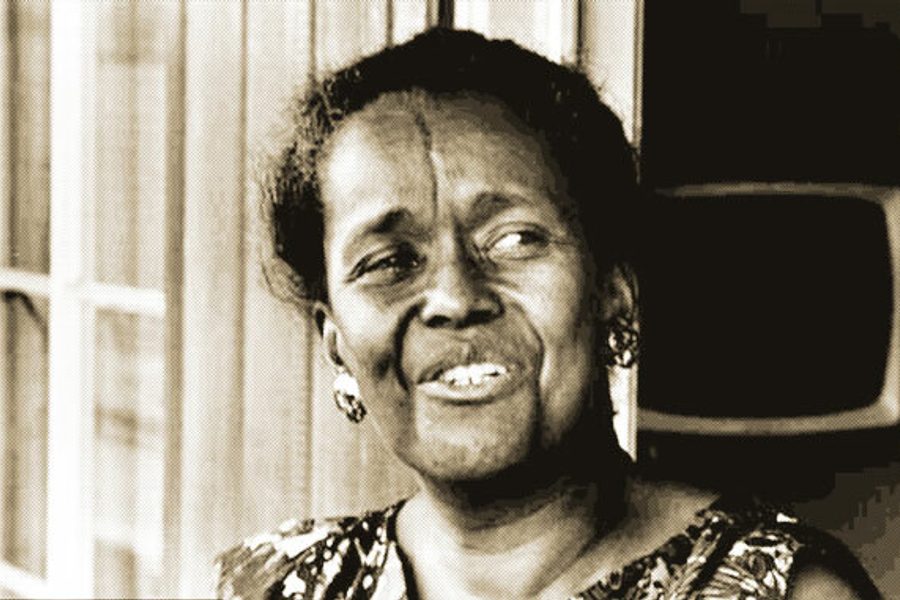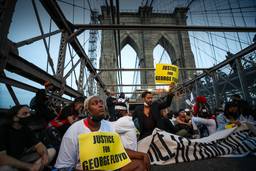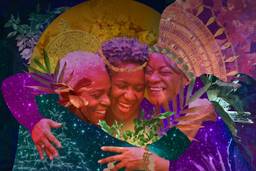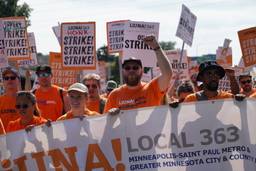Quilting a Movement
Real movements for social change need many grassroots leaders—not one charismatic politician.
Barbara Ransby

Many progressives, especially young people, had their hopes dashed after the 2008 election when President Barack Obama did not deliver on his campaign promises for real fundamental change. There was even greater despair after the GOP took Congress in 2010. But there are lessons here. First and foremost, we cannot rely on a single charismatic figure, no matter how sweet-talking or smooth-walking he is (and it is always a ‘he’ isn’t it?). And we cannot rely on elections alone as our sole mode of political organizing. Slogans and bumper stickers tell us what we need to be doing. “Don’t mourn, organize.” “We are the ones we have been waiting for.” “No one will save us but ourselves.” Yet we still don’t seem to get it.
In order to map our next moves, we would do well to look to the example of the late civil rights leader and radical intellectual Ella Baker. She understood that in order to create a broad-based progressive movement that would fight for palliative reforms and push for institutional change we have to build deep ties (not one time “hook up” coalitions) between diverse communities of activists. It is easier to say “let’s build a movement,” however, than it is to do it. The work is gritty not glamorous, messy not neat, protracted not immediate. As both Baker and Brazilian educator Paolo Freire insisted, we have to engage in active listening as the first step to movement building.
There are a number of obstacles that stand in the way of movement building at this particular juncture. We must reappraise how we have read, or misread, the history of the last 50 years. First, we need to develop a more nuanced understanding of what is derisively termed “identity politics.” Second, we need to comprehend the mechanics of how social justice movements are built. And third, we need to reconsider who we look to for answers, and inspiration.
‘Intersectionality’
Emerging from the turbulent 1960s, activists were fragmented, factionalized and frustrated. In the wake of intense organizing (mainly against war, racism, sexism and poverty), some folks (namely those not in the majority or in a dominant position within either the left or society) felt cynical and skeptical about multi-cultural and multi-issue organizing. In multiracial women’s groups, lesbians and women of color often felt marginal. In labor struggles, undocumented workers and service and temporary workers, as well as black workers in some industries, felt outside of the fold, their concerns not a priority. Demands from people of color, GLBTQ people and women have been read as “divisive” of “big tent” movement efforts. Some black activists felt racism within the left and liberal coalitions dictated a need for all-black organizations. Lesbians saw themselves whited out of the leadership of mainstream feminist struggles as a way to make demands more palatable to a generic public. The examples go on.
What so-called identity groups rejected was not coming together with a diverse array of other progressive folks, but the terms on which we would all come together. This is an important point because some intellectuals have diagnosed the left as suffering from “interest group” politics suggesting that our problem is too much focus on race and gender, and not class. According to Walter Benn Michaels, writing in New Left Review, “It is exploitation, not discrimination, that is the primary producer of inequality today. It is neoliberalism, not racism or sexism (or homophobia or ageism) that creates the inequalities that matter most in American society; racism and sexism are just sorting devices.” We are surrounded by the ubiquitous nonsense about living in a post-racial and post-feminist society. And we are bombarded by articles on the dangers and irrelevance of diversity by left intellectuals in publications like In These Times. For example, John M. Davis writes in the March 2011 issue, “Progressives have become participants in a ‘separate but equal’ scheme. By promoting diversity, we think we are promoting both equality and individual rights. They are not the same thing.”
As a result of such skewed thinking, we are ill-equipped to create the principled, inclusive movement that some of the most oppressed peoples in our society will feel at home in. The reality is class exploitation and racism are not at odds but intimately related, and the progressive movement cannot turn a blind eye to different degrees of privilege and power within our ranks. Still, progressive publications seem to increasingly feel okay with all-white staffs. Left conferences still have to be challenged to not have all-male panels. Non-English speakers, Native Americans and the disabled are often quite literally left out in the cold altogether. Now, this need for “diversity within the left,” if you will, is not an end unto itself. But it is a necessary starting point. And to the extent that we dismiss it, we will continue to have false starts in our movement organizing efforts.
Despite what some of my anti-identity politics colleagues think, important work is being and has been done by folks who began their political sojourn in organizations that focus on issues of race, class, gender, disability status and sexuality.
But within so-called “identity politics,” two schools of thought exist: a liberal “put somebody who looks like me in charge” wing, and a radical wing with a strong structural and class analysis. This latter group is led and inspired primarily by women of color. Women such as Angela Davis (renowned radical and a founder of Critical Resistance), Audre Lorde (the Caribbean-American poet and lesbian activist), Barbara Smith (black feminist writer/activist and co-founder of Combahee River Collective and Kitchen Table Press), Chandra Mohanty (a post-colonial and transnational feminist), Kimberle Crenshaw (Critical Race Theory scholar and constitutional law professor), the late Gloria Anzaldua (a chicano activist and queer theorist), and Andrea Smith (the Cherokee feminist and anti-violence activist), for example.
Despite many caricatures of us, women of color and Third World or postcolonial feminists have rarely, if ever, advocated narrow single issue politics or “my group” versus “your group” politics. Our mantra of “race, class, gender and sexuality” (to which we should add disability/ableism) militates against exclusivity. In fact, what we believe is precisely the opposite of what we are accused of by the anti-identity politics crowd. Most of us reject the problematic term identity politics altogether.
Indeed, rather than separating ourselves from the big tent left, women of color feminists have been in the forefront of a kind of coalition and movement building work. If we accept the idea of ‘intersectionality” (a feminist term that links various overlapping and related forms of oppression into one analysis), the praxis of intersectionality is movement building.
A movement needs many leaders
Our second historical misconception involves the legacy of the Civil Rights Movement, and what that signifies for movement politics today. One of the most powerful social movements of the twentieth century, it did not, as mainstream characterization would have it, rest on the courage of a few heroic men; did not rely heavily on politicians; and often operated outside of large established organizations.
One of the key forces to propel the black freedom struggle forward in the early 1960s was a group of militant young people who borrowed from the wisdom of their radical elders. Out of an historic meeting, in April 1960 the Student Non-Violent Coordinating Committee (SNCC) was born and a new phase of activism began.
Despite what many think, older, predominately male-led, hierarchical organizations like Congress on Racial Equality (CORE), the National Association for the Advancement of Colored People (NAACP) and the Southern Christian Leadership Council (SCLC) were not the key players after 1960.
For example, the national NAACP, as a matter of policy, discouraged its members from engaging in civil disobedience and in fact was known to reign in local members who did not comply. CORE abandoned the 1961 interstate Freedom Rides only to have them taken over by a coalition led by the newly formed and highly-decentralized SNCC. And SCLC, Martin Luther King’s organization, wanted to absorb the young sit-in leaders. SNCC deliberately chose not to join the organization but to launch something new and independent instead.
It was SNCC that would ride the crest of a new wave of protests and provocative electoral campaigns in the South. SNCC’s bold actions revived the Civil Rights Movement in the spring of 1960, which carried over to Freedom Summer in 1964 and the formation of the Mississippi Freedom Democratic Party that same year.
SNCC was not a highly centralized, top down organization like its counterparts. It was a grassroots enterprise that embraced Ella Baker’s notion of group-centered leadership. When asked by reporters, “Who is your leader?” SNCC members would reply, “We all are.” Their more fluid style of community-based leadership was a strength, not a weakness. They did not have to go through bureaucratic chains of command, get approval from higher ups, or cater to wealthy or well-connected funders in order to take action. They were able to adapt and respond creatively to local situations.
Moreover, they were able to take the lead from local organizers who knew their communities. Legendary southern leaders from poor and working class backgrounds like Amzie Moore, Joyce Ladner, June Johnson, Hollis Watkins and Fannie Lou Hamer were able to make their voices heard because of the open and de-centralized structure of SNCC.
Who are your people?
Ella Baker was fond of asking the question – who are your people? She meant where do you come from, but she also meant, who do you identify with? When you have to take sides, where do you stand and who will be there with you? She pushed educated college students to see illiterate sharecroppers as “their people,” their allies and their political mentors. She pushed Northerners to embrace Southerners in principled solidarity. She organized back and forth across various color and cultural lines, and most importantly, across generational divides. In other words, she was a political quilter. She did not advocate forging coalitions of convenience: short-lived and limited. Instead, she wanted to create a movement and nurture the kind of long-term relationships that would sustain it. She tenaciously stitched together fragments of a progessive community into a patchwork of a movement.
Ella Baker taught us how we ought to do our movement work: take time to be inclusive, be active listeners, walk the thorny and sometimes circuitous path of participatory democracy, mutual respect and genuine solidarity; and build campaigns from the bottom up not the top down. Today’s progressives should take these lessons to heart, if they want to succeed in creating the social change our world desperately needs.
Barbara Ransby is a professor at the University of Illinois Chicago, where she directs the Social Justice Initiative and the Portal Project. A feminist and longtime activist, she is author of Ella Baker and the Black Freedom Movement, two other books, and many essays and articles. Her current book project examines the crises of racial capitalism and the response of 21st justice movements.









